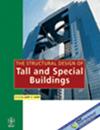Numerical study on wind pressure characteristics of Chinese yurt building under downburst wind
IF 1.3
3区 工程技术
Q3 CONSTRUCTION & BUILDING TECHNOLOGY
引用次数: 0
Abstract
Inner Mongolia is a high‐frequency thunderstorm region in China, and the downburst caused by the thunderstorm weather is a severe threat to buildings. In order to study the influence of downburst on the wind pressure characteristics of the yurt building, the wind field model of the yurt building under downburst is established based on the computational fluid dynamics method, and the effect of the wall treatment method and turbulence model on the numerical simulation of wind pressure of the yurt building under downburst is analyzed. The results demonstrate that the maximum positive pressure at the windward side of the yurt building occurs at 3/4 of the yurt building height under downburst, and the maximum negative pressure at the roof of the yurt building appears at the center of the roof. Compared with the experimental results, the Shear Stress Transport (SST) k‐ω model is suitable for simulating both sides of the yurt building, while the Reynolds Stress equation Model (RSM) is suitable for simulating the windward side, roof, and leeward of the yurt building. The enhanced wall treatment is appropriate for simulating the remaining sides of the yurt building while the standard wall function is appropriate for simulating both sides of the building.下突风条件下中国蒙古包建筑风压特性数值研究
内蒙古是我国雷暴高发区,雷暴天气引起的下击暴流对建筑物构成严重威胁。为了研究下击暴流对蒙古包建筑风压特性的影响,基于计算流体力学方法,建立了蒙古包建筑在下击暴击下的风场模型,分析了壁面处理方法和湍流模型对蒙古包建筑物在下击爆下风压数值模拟的影响。结果表明,在下击暴流作用下,蒙古包建筑迎风侧的最大正压出现在蒙古包建筑高度的3/4处,而蒙古包建筑顶部的最大负压出现在屋顶中心。与实验结果相比,剪切应力传输(SST)k‐ω模型适用于模拟蒙古包建筑的两侧,而雷诺应力方程模型(RSM)适用于模拟帐篷建筑的迎风面、屋顶和背风面。强化墙处理适用于模拟蒙古包建筑的其余侧面,而标准墙功能适用于模拟建筑的两侧。
本文章由计算机程序翻译,如有差异,请以英文原文为准。
求助全文
约1分钟内获得全文
求助全文
来源期刊
CiteScore
5.30
自引率
4.20%
发文量
83
审稿时长
6-12 weeks
期刊介绍:
The Structural Design of Tall and Special Buildings provides structural engineers and contractors with a detailed written presentation of innovative structural engineering and construction practices for tall and special buildings. It also presents applied research on new materials or analysis methods that can directly benefit structural engineers involved in the design of tall and special buildings. The editor''s policy is to maintain a reasonable balance between papers from design engineers and from research workers so that the Journal will be useful to both groups. The problems in this field and their solutions are international in character and require a knowledge of several traditional disciplines and the Journal will reflect this.
The main subject of the Journal is the structural design and construction of tall and special buildings. The basic definition of a tall building, in the context of the Journal audience, is a structure that is equal to or greater than 50 meters (165 feet) in height, or 14 stories or greater. A special building is one with unique architectural or structural characteristics.
However, manuscripts dealing with chimneys, water towers, silos, cooling towers, and pools will generally not be considered for review. The journal will present papers on new innovative structural systems, materials and methods of analysis.

 求助内容:
求助内容: 应助结果提醒方式:
应助结果提醒方式:


